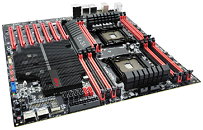Monday, February 13th 2012

EVGA SR-X Dual-Socket LGA 2011 Motherboard Teased Some More
Wondering what's going on with EVGA's SR-X motherboard? Well the board still isn't ready for release but EVGA has made progress on it, as is confirmed by a new image provided by the US-based company. This photo showcases the SR-X in a near final stage, equipped with an updated cooling solution made up of four heatsinks (covering VRM areas and chipsets).
As previously reported, the SR-X comes with two LGA 2011 sockets (it supports Sandy Bridge-E CPUs for single-processor setups and Sandy Bridge-EP CPUs for dual-chip configurations), 12 DDR3 memory slots (up to 96 GB of RAM are supported), two (one 8-pin and one 6-pin) power connectors per CPU, six SATA and four SAS (Serial Attached SCSI) ports, seven PCI-Express 3.0 x16 slots (SLI and CrossFireX support is included), PCIe disable switches, voltage read points, a debug LED, dual Gigabit Ethernet, two eSATA ports, 7.1 channel audio, Bluetooth, EVBot support, and six USB 3.0 connectors (four on the back plate, two via a header).
EVGA is promising more details about the SR-X (a price tag and an availability date maybe) 'soon'. CeBIT anyone?
Source:
Twitpic
As previously reported, the SR-X comes with two LGA 2011 sockets (it supports Sandy Bridge-E CPUs for single-processor setups and Sandy Bridge-EP CPUs for dual-chip configurations), 12 DDR3 memory slots (up to 96 GB of RAM are supported), two (one 8-pin and one 6-pin) power connectors per CPU, six SATA and four SAS (Serial Attached SCSI) ports, seven PCI-Express 3.0 x16 slots (SLI and CrossFireX support is included), PCIe disable switches, voltage read points, a debug LED, dual Gigabit Ethernet, two eSATA ports, 7.1 channel audio, Bluetooth, EVBot support, and six USB 3.0 connectors (four on the back plate, two via a header).
EVGA is promising more details about the SR-X (a price tag and an availability date maybe) 'soon'. CeBIT anyone?

39 Comments on EVGA SR-X Dual-Socket LGA 2011 Motherboard Teased Some More
The dual core FX CPUs it was originally designed for could overclock to a level where they'd keep up with a low-end 45nm Phenom or Athlon quad. With about 350W power use between them, of course.
8GB of DDR2 also is no major issue today. And 12 Sata 2 ports and 48 PCI-E lanes are more than most of us manage now :P
This TH review somewhat amusingly shows the platform getting beaten by a QX6700, but says that it will come into its own once quad-core CPUs are released for it. Over 5 years later, Asus's support list still doesn't mention anything beyond the launch CPUs.
I think you could expect roughly Q8200/Q6600 level performance most of the time, but with 2-3 times the power requirements.
Wouldn't need an entire board to run setups like this, just a simple card that seats two CPUs. Issue would be, you'd need a custom heatsink design to do it. Power requirements would change too so likely the card would need it's own VRM setup with power connector similar to the 7447s Powerlogix used in the G4 Cube upgrades. Maybe some implementation done on the socket to support it too.
Cost to dev all this is likely prohibitive. Might as well just add more cores or work on improving designs. But for servers, be a pretty simple way to add more performance. Give another upgrade option.
:toast:
I will take three (I wish):)
'six SATA and four SAS (Serial Attached SCSI) ports'
6 + [4 x 4 (via SAS to Reverse SATA breakout cables] = 6 + 16 = 22 HDDs :cool:
Not bad if they can keep it all in the financial reach of traditional setups (LSI SAS 2008 chip based controller in HBA/IT mode with a SAS Expander from my observations/experience) people use in File Servers pushing those numbers (anything but a budget build given current HDD prices :eek: )